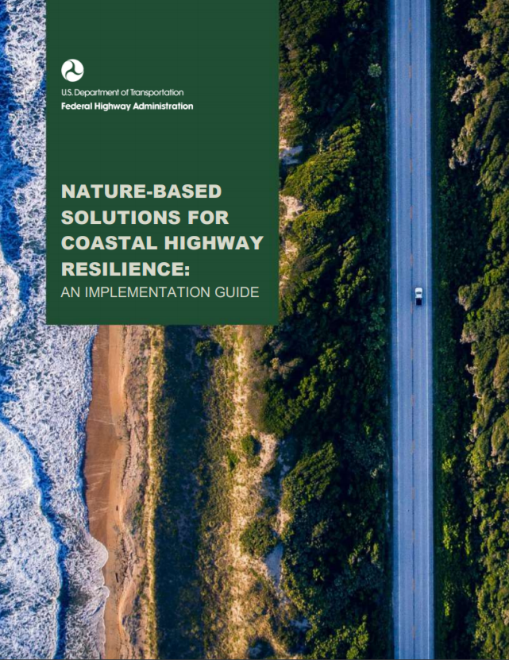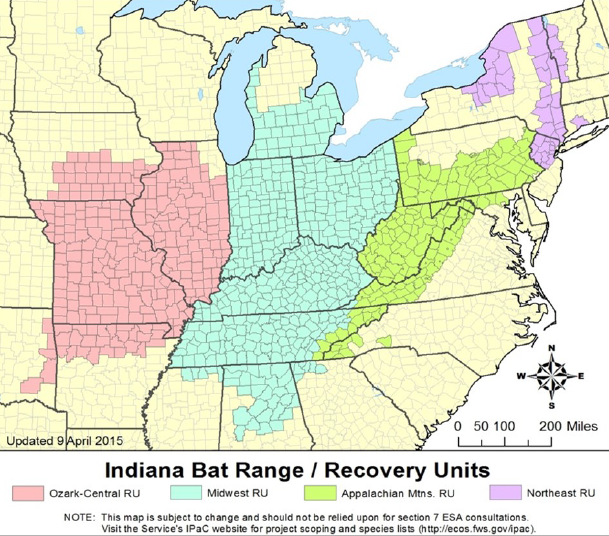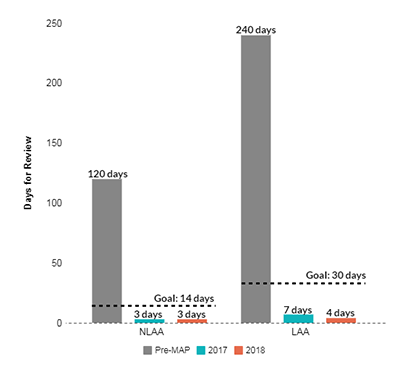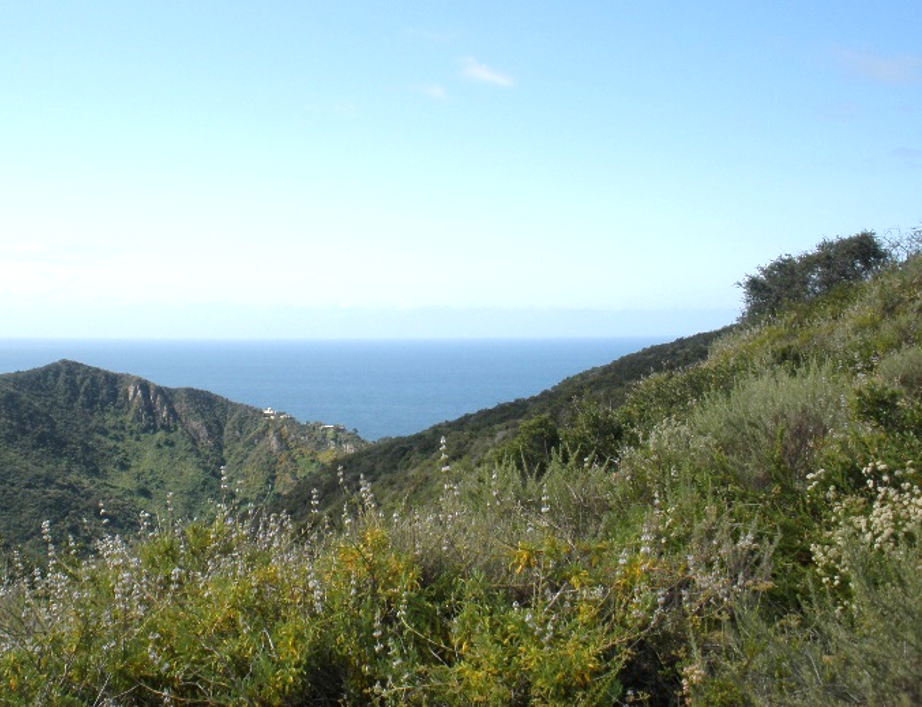
2018-2020 in Review: Key Takeaways for Accelerating Project Delivery
and Improving Environmental Outcomes
Between 2018 and 2020, transportation agencies nationwide made significant strides toward accelerating project delivery while improving environmental outcomes. Agencies embraced collaborative and innovative approaches to transportation planning, resulting in accelerated projects that meet communities’ needs. From highlighting exemplary practices such as the rangewide programmatic consultation on Indiana Bat and Northern Long-Eared Bat and Eco-Logical project implementation, to communicating the benefits of green infrastructure for safe and resilient projects, each issue of Successes in Stewardship has distilled fundamental knowledge and best practices for transportation and environmental practitioners to incorporate into their agency’s work processes. This issue compiles the key takeaways from several issues over the past few years, focusing on the tools and critical knowledge to enhance and accelerate environmental reviews.
Ecological Benefits
of Nature-Based Solutions
In addition to benefits to transportation systems, coastal green infrastructure can provide:
- Improved water quality by reducing nitrogen, phosphorous, and sediments;
- Opportunities for recreational fishing, kayaking, paddle boarding, and bird watching;
- Enhanced and protected habitat used as nursery areas and for foraging by fish, mollusks, crustaceans, turtles, and birds;
- Increased biodiversity; and
- Carbon sequestration.
Best Practices for Coastal Highway Resilience
The July 2018 issue of Successes in Stewardship highlighted the co-benefits of projects that contribute to safe and connected pedestrian and bicycle networks and also provide green infrastructure to improve resiliency and relieve burdens on stormwater systems. In related work, the Federal Highway Administration (FHWA) developed Nature-Based Solutions for Coastal Highway Resilience: An Implementation Guide to help transportation professionals understand when, where, and which nature-based solutions may work for their communities, and how to design and implement them.
Nature-based solutions for coastal resilience use natural materials and processes to mitigate erosion, wave height, and coastal flooding, which serve as alternatives to, or ecological enhancements of, traditional shoreline stabilization and infrastructure protection techniques. Examples include conservation, restoration, or construction of beaches, dunes, tidal marshes, mangroves, maritime forests, and reefs.
Generally, nature-based approaches provide more cost-effective mitigation than increasing the elevation of infrastructure. Nature-based solutions often cost less than or equal to traditional shoreline armoring and have lower replacement costs following extreme events. Unlike traditional shoreline hardening using bulkheads, walls, or revetments, nature-based solutions have the capacity to adapt naturally over time, on their own, through biological, ecological, and geological processes. However, nature-based solutions may require more routine maintenance than traditional shoreline protection.
The majority of the guide is organized around how nature-based solutions can be developed through the transportation project delivery process.

Figure 1. Illustration. FHWA’s implementation guide provides transportation practitioners step-by-step recommendations for integrating green infrastructure for coastal resilience.
Source: FHWA
- Planning and funding: FHWA’s Eco-Logical approach provides a framework for integrating ecosystem planning with transportation planning through early engagement with strategic partners and regulators. Close coordination can help leverage funding from across the transportation, coastal restoration, and hazard mitigation sectors.
- Site assessment: Site characterization is the process by which transportation planners develop an understanding of site conditions, including relevant physical, ecological, and geological processes. Resilience characterization identifies the transportation project’s vulnerabilities, resilience requirements (e.g., flood reduction, erosion reduction, shoreline stabilization, and wave attenuation), and environmental benefits that a nature-based solution may provide. Together, site and resilience characterization can help transportation planners identify and implement technically feasible, reasonable, justifiable, and constructible nature-based solutions.
- Design considerations: Transportation professionals, working as part of a cross-functional team of coastal engineers and scientists, determine the placement, size, and combinations of materials based on desired risk reduction and ecological performance. The guide describes engineering design considerations for marsh sills and toe revetments, vertical sills, breakwaters, vegetation, geotextiles, reefs, dunes, beach nourishment, and sediments for beaches and dunes. Hydrodynamic modeling and empirical methods are employed to analyze the design’s protection level and make adjustments to the design, as needed. The guide also presents several ecological design considerations (e.g., habitats, species, and water quality) that should be analyzed to understand ecosystem impacts and services of the nature-based solution.
- Permitting: Most nature-based solutions are subject to regulatory review by Federal and State agencies for compliance with the Clean Water Act (CWA) Section 404, CWA Section 401, Endangered Species Act, National Historic Preservation Act, and Coastal Zone Management Act. The guide covers typical U.S. Army Corps of Engineers (USACE) permits and processes, as well as National Environmental Policy Act (NEPA) compliance for transportation project nature-based solutions, and shows how transportation professionals can incorporate nature-based solutions to meet mitigation requirements, gain mitigation credits, offset environmental impacts, or meet permit requirements.
- Construction: The guide presents considerations for using performance-based contracting to construct nature-based solutions, performing work with heavy equipment in soft subsurface soils, land- and water-based construction methods, and timing to accommodate tides.
- Monitoring, maintenance, and adaptive management: Monitoring a project’s performance provides an opportunity to measure and assess benefits, identify potential adaptive management needs, and refine designs for future projects. The guide offers maintenance considerations and notional cost estimates for several nature-based solutions.
Updates to the Rangewide Indiana Bat and Northern Long-Eared Bat Programmatic Consultation
The March 2018 issue of Successes in Stewardship focused on the status of the Indiana Bat and Northern Long-Eared Bat Programmatic Consultation, which covers the effects of select transportation actions undertaken by FHWA, Federal Railroad Administration (FRA), Federal Transit Administration (FTA), and State departments of transportation (State DOTs). In accordance with the programmatic biological opinion (PBO), annual reports covering the period from May 2016 through December 2019 were completed in October 2018, April 2020, and September 2020.

Figure 2. Map. The programmatic consultation has been used broadly across the geographic service area.
Source: FHWA.
During the 2017/2018 reporting period, FHWA, FRA, FTA, and State DOTs used the PBO for 3,925 projects, a significant increase in terms of both the number of users and projects from the previous reporting period. In the 2019 reporting period, 3,316 projects used the PBO. The PBO has significantly increased the efficiency of project review. Previously, agency policies called for informal consultations to be completed in 30 days, and statutory requirements called for formal consultations to be completed in 135 days. Under the PBO, the review deadline was shortened to 14 days for projects classified as “Not Likely to Adversely Affect” (NLAA) and 30 days for projects classified as “Likely to Adversely Affect” (LAA). Most reviews were completed even faster than the new deadlines required: on average, NLAA project reviews were completed in 12 days in 2017/2018 and 13 days in 2019, and LAA project reviews were completed in 17 days in 2017/2018 and 22 days in 2019.
The Rangewide Indiana Bat in-lieu fee (ILF) program was established by the U.S. Fish and Wildlife Service (USFWS) and The Conservation Fund (The Fund) in July 2017 to provide an ILF option to compensate for unavoidable impacts to Indiana bats and their habitats. As of December 2019, The Fund has received a total of 56 confirmation documents for 129.8 acres of impacts, which translates into 171 acres of protected bat habitat.
The programmatic consultation has yielded time and cost savings. For example, prior to the PBO, Maine Department of Transportation (MaineDOT) would spend an estimated $6,000-$10,000 on 60-80 staff hours per project for individual consultations; under the PBO, costs are reduced to approximately $1,000-$2,000 on 8-9 staff hours per project.
In June 2019, FHWA, FRA, FTA, and USFWS published Version 5.0 of the User’s Guide for the Range-wide Programmatic Consultation for Indiana Bat and Northern Long-eared Bat, which reflects changes in response to input from users and the 2018 revised PBO. The document provides guidance for implementation of the programmatic consultation for both transportation agencies and USFWS Field Offices. Since March 2018, other supporting implementation documents have been updated as well, including the Project Submittal Form (revised June 2019) and Bridge/Structure Assessment Guidance and Form (updated April 2020). USFWS and FHWA are in the process of updating the PBO and supporting implementation documents in 2021. More information on the updated documents will be available on the USFWS Indiana Bat and Northern Long-eared Bat Section 7 Consultation and Conservation Strategy website.
Maine Department of Transportation Atlantic Salmon Programmatic Consultation
In 2017, FHWA, MaineDOT, USFWS, USACE, and the Maine Turnpike Authority developed a programmatic consultation for the federally-listed endangered Atlantic salmon that includes its critical habitat, an effort showcased in the January 2019 issue of Successes in Stewardship. The Atlantic Salmon Programmatic Consultation saw its second full year of implementation in 2018, where MaineDOT focused on ways to enhance the program and increase project coverage. Monitoring of completed projects has improved regulatory compliance and ensured beneficial environmental outcomes, while adaptive management has allowed MaineDOT and its partners to incorporate new information to adjust the program to meet efficiency and conservation goals. The ILF program, which was finalized at the end of 2018, is another tool that can add greater flexibility to the programmatic consultation process.

Figure 3. Chart. Atlantic salmon NLAA and LAA determination timelines were significantly reduced as a result of the programmatic. Source: FHWA/MaineDOT.
Not only has the programmatic consultation led to significant habitat restoration for the Atlantic salmon, but it has also helped improve trust and cooperation among agencies, increased predictability, saved time and money, and improved the resiliency of completed projects.
In 2018, the programmatic consultation process led to:
- Reduced consultation processing timelines (Figure 3):
- Reduction of NLAA review timelines compared to before the programmatic consultation, from 120 days to 3 days.
- 56 percent faster processing of formal consultations compared to 2017.
- 56 percent increase in number of completed consultations compared to 2017.
- Habitat restoration:
- 4.65 acres of critical habitat for Atlantic salmon restored.
- Accelerated project delivery:
- 36 projects reviewed and 14 projects completed, an increase from year one implementation.
More information on implementation of the consultation is available in the Year Two Snapshot.
Eco-Logical Case Study: Programmatic Advance Mitigation for the M2 Program Transportation Project
In June 2021, FHWA published a case study on the development of an advance compensatory mitigation program for projects included in the Orange County Transportation Authority (OCTA) M2 Highway/Freeway Program (M2 Program). The M2 Program addresses long-term transportation needs in Orange County by planning and funding a suite of 13 transportation projects, which include road, rail, transit, and run-off improvements over 30 years through a sales tax initiative. The case study details how OCTA engaged State and Federal permitting agencies in an innovative approach akin to Eco-Logical to develop mechanisms allowing for advance compensatory mitigation for these projects.
Establishing Key Partnerships and Agreements
OCTA, the USACE Los Angeles District, USFWS, and California Department of Fish and Wildlife (CDFW) partnered to create viable and streamlined environmental permitting solutions to satisfy multiple agency requirements for an entire project portfolio while ensuring protection of threatened and endangered species and sensitive habitats in Southern California. The project-specific Natural Community Conservation Plan/Habitat Conservation Plan (Conservation Plans), Section 404 CWA letter of permission (LOP) procedures, Section 401 CWA assurance letter, and Section 214 Water Resources Development Act (WRDA) Funding Agreement between USACE and OCTA address permitting and mitigation needs for the M2 Program. In turn, these mechanisms expedite environmental review for individual M2 Program projects and improve environmental outcomes.
Creating an Ecosystem Framework
Agencies collaborated to develop Conservation Plans that protect and enhance ecological diversity and function and enhance the integrity and connectivity of existing protected lands in Orange County. The Conservation Plans address the projects’ impacts to wildlife resources and establish avoidance and minimization measures to offset anticipated impacts from M2 Program projects. Furthermore, they developed a framework to establish seven preserves, fund restoration projects to address the required biological mitigation, and ensure that resources are conserved or maintained in perpetuity. Through efforts under the Conservation Plans, agencies have helped clean up local waterways and ensure the protection of 13 sensitive species in their native habitat.

Figure 4. Photographs. OCTA’s managed preserves provide habitat for 13 sensitive “covered species” under the Conservation Plan, such as the cactus wren, coast horned lizard, bobcat, and the intermediate Mariposa lily (listed from left to right). Source: OCTA/FHWA.

Figure 5. Photograph. OCTA’s Environmental Mitigation Program has allowed for the purchase of 1,300 acres to preserve a variety of important habitats. Source: FHWA/OCTA.
USACE established Section 404 CWA LOP procedures to provide a programmatic approach for review of Section 404 CWA permit applications and identification of compensatory mitigation for unavoidable losses of waters of the U.S. (WOTUS) resulting from M2 Program construction activities. A LOP is a streamlined form of an individual permit ’issued through an abbreviated processing procedure which includes coordination with Federal and State fish and wildlife agencies, as required by the Fish and Wildlife Coordination Act, and a public interest evaluation, but without the publishing of an individual public notice” (33
CFR
325.2(e)(1)). The LOP procedures enabled more efficient permitting and improved environmental outcomes through:
- Honoring the sales tax commitments made through the M2 Program, which provides comprehensive environmental mitigation for related projects;
- Providing a programmatic mechanism for approving compensatory mitigation in advance of planned M2 project impacts to WOTUS;
- Remaining valid to support the remaining 20-year timeframe of the M2 Program; and
- Providing a mechanism to approve compensatory mitigation for watersheds requiring in-watershed mitigation that was previously unattainable due to a lack of mitigation banks or availability of ILF credits.
The State Water Resources Control Board (SWRCB) issued a CWA Section 401 assurance letter, streamlining the water quality certification review process for water impacts by M2 Program projects.
Reviewing and Implementing the M2 Projects
USACE and OCTA entered into a Section 214 WRDA Funding Agreement to accelerate USACE’s development of the Section 404 LOP procedures and review of subsequent Section 404 CWA LOP applications for M2 Program projects. The agreement allows OCTA to fund the work of a dedicated reviewer at USACE who can expedite the review of OCTA’s priority permit applications and related efforts.
These mechanisms allowed OCTA and California Department of Transportation (Caltrans) to break ground on a suite of vital transportation projects and provide substantial protection, conservation, and restoration benefits consistent with USACE, USFWS, and CDFW missions. The effort yielded several benefits:
- Developed a programmatic approach that addresses projects up to 30 years into the future and expedites environmental review;
- Established an advanced mitigation framework that accelerates project-level approvals;
- Established a coordinating body that dedicates time and resources for agency collaboration;
- Provided consistency and certainty that reduces project risk;
- Enhanced conservation measures that provide improved environmental and community outcomes; and
- Provided managed recreational opportunities for the public.
The case study identifies several best practices and lessons learned that may be applied to similar efforts, including engaging all potential stakeholders in early coordination, identifying all impacted resources, dedicating staff and documenting efforts, dedicating funding, creating partnerships, and considering long-term benefits over short-term costs.
Contact Information
Best Practices for Coastal Highway Resilience
Elizabeth Habic
FHWA Office of Natural Environment
(202) 336-1701
Elizabeth.Habic@dot.gov
Updates to the Indiana Bat and Northern Long-Eared Bat Programmatic Consultation
Dan Buford
FHWA Office of Project Development and Environmental Review
(202) 336-8168
Daniel.Buford@dot.gov
Brian Yanchik
FHWA Resource Center
(410) 218-4454
Brian.Yanchik@dot.gov
Maine Department of Transportation Atlantic Salmon Programmatic Consultation
Eco-Logical Case Study: Programmatic Advance Mitigation for the M2 Transportation Project
David Williams
FHWA Office of Project Development and Environmental Review
(202) 366-4074
David.Williams@dot.gov
Mike Ruth
FHWA Resource Center
(912) 665-1315
Mike.Ruth@dot.gov
Successes in Stewardship is a Federal Highway Administration newsletter highlighting current environmental topics, with an emphasis in accelerated project delivery and stewardship practices from around the country. Click here to subscribe, or call (617) 494-2129 for more information.

